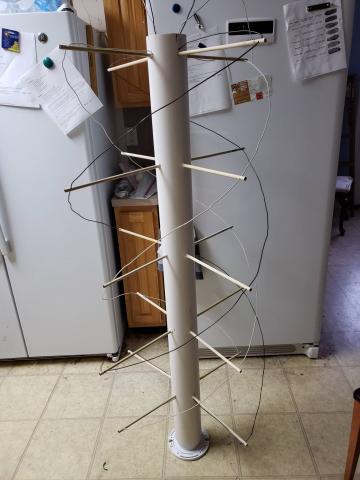Well, I finally went and did it. I built the 6-meter quadrifilar helix I've been talking about for years. Okay, it's not quite done, I'm waiting for a decent pair of wire strippers to arrive, but a week ago I took a four-inch PVC pipe, some 3/8 inch dowels, some Romex, and adhesive and fabricated a QFH antenna. I used a short Python program I wrote to determine the dimensions and, well, I did it wrong. The short wire in what I built should be the long wire at the operating frequency, so the whole thing is too long for the 52 MHz design frequency. However, I'm going to finish it and see how it works before reworking it. Maybe I won't have to rework it at all. My big problem is that this antenna really should go on the roof, but I don't have any way of mounting it up there, so maybe in the attic?
In the mean time, I've been working on the keyer software, off and on. I implemented the manual and semiautomatic modes of the dongle and I've been practicing with this single-paddle key I bought. There are only two modes left that I haven't implemented: "Iambic-B" and "Ultimatic." Since I don't use either of those modes, I'm not in any sort of hurry to implement them. That means that the dongle firmware is done. For the moment.
With the keyer dongle basically done for now, I have turned my attention to the UI portion of it. The UI has always been intended to be implemented in Python and run on a Raspberry PI with a touchscreen, but for development I'm just running it on my development computer. I've added the ability to switch keyer modes and reverse the paddles, a handy thing because my single-paddle key and my Bencher paddles are wired backwards from each other, and I'm thinking about how to do the recording of messages so I can use this as a memory keyer. It's a matter of just figuring out how the UI should look because the Python program sees all of the keying done by the dongle and, in fact, I get Morse to text of what I send even when I'm using the manual or semiautomatic modes. I didn't realize the Morse to text would be that robust. I guess it only works because I'm sending at about the same speed manually as I do when I am using the Iambic modes.
My intention is to upload everything, the schematics, the gerber files, Arduino and Python source, to github and link the github to the Oshpark project. That will take some work, and I've been thinking about how I want to organize this project in the long term. The main sticking point is the current version, with a potentiometer as a speed control, is only a stepping-stone to get to the version with the rotary encoder. Since it's a stepping-stone, I don't want to go to a lot of extra trouble making it available, but I also don't want to make everyone wait for the possibly extended amount of time it will take me to get the rotary encoder version going. Anyway, I will try to have something out there soon.

